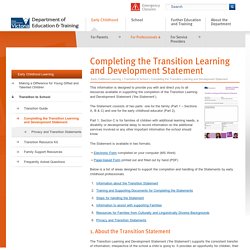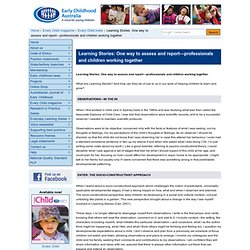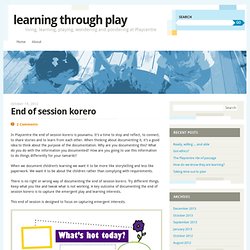

VEYLDF Module 4: Assessment for Learning and Development: the Early Years Planning Cycle - FUSE - Department of Education & Training. Appropriate and meaningul assessment elicker by NAEYC. Completing the Transition Learning and Development Statement. This information is designed to provide you with and direct you to all resources available in supporting the completion of the Transition Learning and Development Statement (‘the Statement’).

The Statement consists of two parts: one for the family (Part 1 – Sections A, B & C) and one for the early childhood educator (Part 2). Part 1, Section C is for families of children with additional learning needs, a disability or developmental delay to record information on the additional services involved or any other important information the school should know. The Statement is available in two formats; Electronic Form completed on your computer (MS Word)Paper-based Form printed out and filled out by hand (PDF) Below is a list of areas designed to support the completion and handling of the Statements by early childhood professionals. 1.
The Transition Learning and Development Statement (‘the Statement’) supports the consistent transfer of information, irrespective of the school a child is going to. Montessori Australia. Www.education.vic.gov.au/Documents/childhood/providers/regulation/042013edprogrampractice.pdf. Vol 7 No 2. Wondering with Children: The Importance of Observation in Early Education. Share Mirar esta página en españolHomeJournal ContentsIssue ContentsVolume 7 Number 2©The Author(s) 2005 Wondering with Children: The Importance of Observation in Early Education George Forman & Ellen Hall Videatives, Inc.

Amherst, Massachusetts This paper asserts that through the process of observation, documentation, and interpretation of children's goals, strategies, and theories, teachers gain insight into children's thinking. As a result of this process, teachers are better able to engage children in conversations and investigations that have the potential to extend their learning in both depth and breadth. Children are sometimes spontaneous, sometimes reserved; joyful now, sad later; friendly and reserved; competent and naïve; talkative and quiet. Given the delightful yet often enigmatic characteristics of young children, we learned decades ago that in order to comprehend children we must begin by observing them as they play. Professional Learning. The Victorian Early Years Learning and Development Framework (VEYLDF) supports all professionals who work with children from birth to eight years by providing a common language for describing outcomes for children, and describing practice principles to guide early childhood professionals to work together, with children and with families to achieve the best outcomes for every child.

Professional learning is available to support early childhood professionals to embed the VEYLDF in their daily practice. Reflect Respect Relate: Two day learning program Reflect, Respect, Relate: Assessing for Learning and Development in the Early Years Using Observation Scales is a resource developed in South Australia by leading academics and practitioners. It grew out of the understanding that learners who have deep engagement in learning achieve optimal outcomes. For more details, and to access the online application and view participant expectations, visit: Gowrie Victoria Special Events.
Edleaders.weebly.com/uploads/1/4/5/5/14554682/teachers_ink_eylf_quick_reference_guide_2013.pdf. Infographic - Types of play for learning in ... Learning Stories: One way to assess and report—professionals and children working together. Learning Stories: One way to assess and report—professionals and children working together Learning Stories: One way to assess and report—professionals and children working together What are Learning Stories?

And how can they be of use to us in our work of helping children to learn and grow? When I first worked in child care in Sydney back in the 1980s and was studying what was then called the Associate Diploma of Child Care, I was told that observations were scientific records, and to be a successful observer I needed to maintain scientific protocols. Observations were to be objective, concerned only with the facts or features of what I was seeing, not my thoughts or feelings, nor my perceptions of the child’s thoughts or feelings. When I learnt about a socio-constructivist approach which challenges the notion of predictable, universally applicable developmental stages, it had a strong impact on how, what and when I observed and planned. Professional Learning. Learning through play. In Playcentre the end of session korero is pounamu.

It’s a time to stop and reflect, to connect, to share stories and to learn from each other. When thinking about documenting it, it’s a good idea to think about the purpose of the documentation. Why are you documenting this? What do you do with the information you documented? Www.naeyc.org/files/tyc/file/Seitz. Www.everychild.sa.gov.au/docs/Childrens_Voices_booklet_web.pdf. Www.earlychildhoodaustralia.org.au/nqsplp/wp-content/uploads/2013/07/NQS_PLP_E-Newsletter_No57. Documenting Montessori. Learning Stories. The Ten Commandments of Play-Based Learning. My day-to-day work with young children paired with the here-and-there trainings and consultations I do with other early childhood professionals continue to teach me this: one of the most difficult lines to toe in the complex world of play-based learning is the one that separates “too involved” from “disengaged”.

Scores of us champion the young child’s right to play, but the intricacies of such work are more difficult to articulate. In an effort to articulate how I discern the line, I have created a Ten Commandments-esque list, having just listened to one of my all time favorite episodes of This American Life. This list captures my guiding principles when it comes to accompanying children through play-based learning. Despite appearances to the contrary, I do not view this list as exhaustive, and if you have your own to add, I’d love to hear them in the comments below. The Ten Commandments of Play-Based Learning 10. 9. 8. 7. 6. 5. 4.